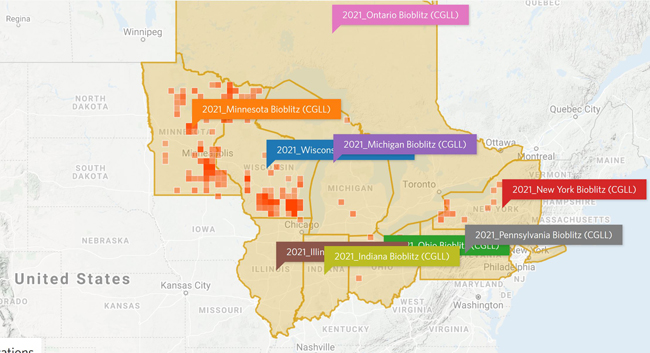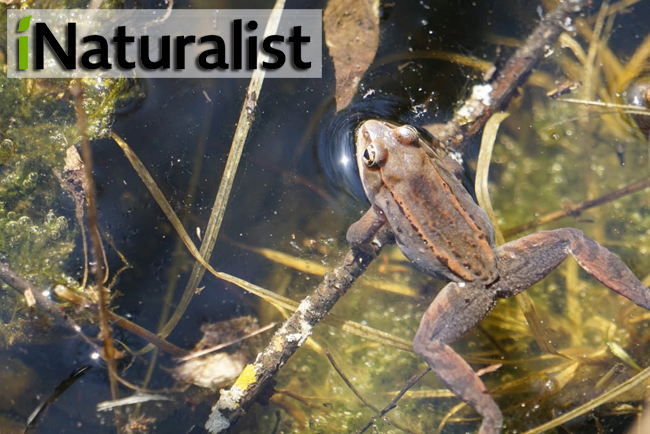Stony Brook and Buffalo, NY, July 26, 2021 - Sea Grant programs from throughout both the Northeast and Great Lakes regions, including New York, supported “Bioblitz” this past spring and summer, community science efforts to record as many species as possible within a designated location and time period.
New Yorkers had an opportunity to get involved with two events recently, including the Long Island Sound Coastal Bioblitz (late June—early July) and the Great Lakes Bioblitz (late April—late May).
The Long Island Coastal Bioblitz is an event to engage the Long Island community in exploring all of the island’s incredible habitats and species diversity. Hosted in partnership with Seatuck Environmental Association, Long Island Sound Study, Peconic Estuary Partnership, South Shore Estuary Reserve, New York Sea Grant, and the Long Island Invasive Species Management Area, one of the main goals of the Bioblitz is to better understand the ecological community and biodiversity around Long Island. This information can guide environmental groups in better preserving important habitats and wildlife.

Regarding the Great Lakes Bioblitz, compare observations made in New York with those from Minnesota, Wisconsin, Michigan, Illinois, Indiana, Ohio, Pennsylvania, New York, and Ontario.
For either of these events, participants were invited to follow a few quick steps: Visit www.inaturalist.org on your computer, or download the iNaturalist app from your app store onto your mobile device: (1) Create an account (free); (2) Become a member of either [your region] Bioblitz (CGLL) project or the Long Island Coastal Bioblitz project; (3) For those signing up for regionally for the Great Lakes Bioblitz, they were also asked to become a member of the Great Lakes Bioblitz (CGLL) “umbrella” project; (4) Start making observations!
Given that, especially during the Great Lakes Bioblitz, some COVID-19 restrictions were still in place, we encouraged participants to discover biodiversity in their own neighborhood ... (a) Check for insects in gardens and look for plants in parks or along walking paths; (b) At home, look under patio furniture, or install an outdoor light fixture to attract bugs and insects; (c) In forests, check underneath fallen logs, or inside of tree trunks; (d) Ponds, streams, and lakes are filled with plenty of species to snapshot, too!; (e) Document the birds you spy in the waters nearby, in tall grassy areas, or anywhere else.

More Info: Long Island Sound Study
Long Island Sound is one of the 28 nationally designated estuaries under the National Estuary Program (NEP), which was established by Congress in 1987 to improve the quality of Long Island Sound and other places where rivers meet the sea.
The Long Island Sound Study is a cooperative effort sponsored by the Environmental Protection Agency and the states of Connecticut and New York to restore and protect the Sound and its ecosystems. The restoration work is guided by a Comprehensive Conservation and Management Plan under four themes: Clean Waters and Healthy Watersheds; Thriving Habitats and Abundant Wildlife; Sustainable and Resilient Communities; and Sound Science and Management.
For more on what you can do to make a difference, click over to the "Get Involved" or "Stewardship" sections of the Long Island Sound Study's website. News on the Long Island Sound Study can also be found in New York Sea Grant's related archives.
If you would like to receive Long Island Sound Study's newsletter, please visit their site's homepage and sign up for the "e-news/print newsletter" under the "Stay Connected" box.
More Info: New York Sea Grant
New York Sea Grant (NYSG), a cooperative program of Cornell University
and the State University of New York (SUNY), is one of 34 university-based
programs under the National Oceanic and Atmospheric Administration’s
National Sea Grant College Program.
Since 1971, NYSG has represented a statewide network of integrated
research, education and extension services promoting coastal community
economic vitality, environmental sustainability and citizen awareness
and understanding about the State’s marine and Great Lakes resources.
Through NYSG’s efforts, the combined talents of university scientists
and extension specialists help develop and transfer science-based
information to many coastal user groups—businesses and industries,
federal, state and local government decision-makers and agency managers,
educators, the media and the interested public.
The program maintains Great Lakes offices at Cornell University, University at Buffalo, SUNY Oswego and the Wayne County Cooperative Extension office
in Newark. In the State's marine waters, NYSG has offices at Stony Brook
University in Long Island, Brooklyn College and Cornell Cooperative
Extension in NYC and Elmsford and Kingston in the Hudson Valley.
For updates on Sea Grant activities: www.nyseagrant.org has RSS, Facebook, Twitter, Instagram, and YouTube links. NYSG offers a free e-list sign up via www.nyseagrant.org/nycoastlines for its flagship publication, NY Coastlines/Currents, which is published quarterly.